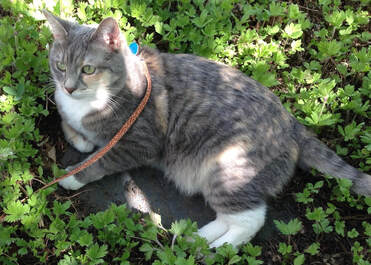Where the Wild Things Are

Pets and Coronavirus
In June 2019, we lost our beautiful, gentle cat to Feline Coronavirus (FCoV) after the virus mutated and lead to the development of feline infectious peritonitis (FIP). This eventually caused fatal accumulation of fluid in the abdominal cavity, the chest cavity, or both. Our cat was a rescue cat, and may have picked up the virus in a colony or in her birth family. The virus is typically shed in the feces and can remain active for several weeks; therefore, a litter box from an infected cat needs to be sanitized well before reuse. Transmission between cats increases in colonies and multi-cat households, but FCoV cannot be transmitted to humans.
With the current COVID19 pandemic, questions about the transmission from humans to pets arise. So far, it appears that the risk of transmitting COVID19 from a human to pet is very low. However, caution with pets that roam widely is advised. More info here.
Cats and Birds
We love cats and hope to enjoy the company of a feline buddy for many years. But to be blunt, domestic cats are clever killers that should not be allowed to roam. While they are adorable and relatively easy to keep, their hunting instincts and ample leisure time are a recipe for disaster once they are on the loose outdoors. In the US alone, both pet and stray cats kill some 1.4 to 3.7 billion songbirds per year, plus many more billions of reptiles and amphibians. If you are curious about the history of our fascination with cats and their impact on wildlife population, check out "The Lion in the Living Room - How House Cats Tamed Us and Took Over the World" by Abigail Tucker.
The best course of action, to save our wild species from the claws and fangs of our cuddly cats, is to keep them indoors. Cat rescue societies strongly encourage cat lovers to keep them indoors for their own protection from traffic, coyotes, from getting into fights with other animals, and from getting sick. Many cats are now trained to feel comfortable in a harness and to "walk" on a leash. This gives them a chance to sniff around the yard, enjoy some sunshine, and watch birds and insects from a safe distance, without a way to make a kill.
Some organizations encourage cat owners to enter a pledge to keep their cats indoors, and educate themselves about the lives and beauty of songbirds. Birdwatching is a wonderful family activity that we also love, and kitty can do the same from a window seat. Let's help protect our wild garden creatures while enjoying the company of our cats inside. For more info, check out Nature Canada's "Cats and Birds".
In June 2019, we lost our beautiful, gentle cat to Feline Coronavirus (FCoV) after the virus mutated and lead to the development of feline infectious peritonitis (FIP). This eventually caused fatal accumulation of fluid in the abdominal cavity, the chest cavity, or both. Our cat was a rescue cat, and may have picked up the virus in a colony or in her birth family. The virus is typically shed in the feces and can remain active for several weeks; therefore, a litter box from an infected cat needs to be sanitized well before reuse. Transmission between cats increases in colonies and multi-cat households, but FCoV cannot be transmitted to humans.
With the current COVID19 pandemic, questions about the transmission from humans to pets arise. So far, it appears that the risk of transmitting COVID19 from a human to pet is very low. However, caution with pets that roam widely is advised. More info here.
Cats and Birds
We love cats and hope to enjoy the company of a feline buddy for many years. But to be blunt, domestic cats are clever killers that should not be allowed to roam. While they are adorable and relatively easy to keep, their hunting instincts and ample leisure time are a recipe for disaster once they are on the loose outdoors. In the US alone, both pet and stray cats kill some 1.4 to 3.7 billion songbirds per year, plus many more billions of reptiles and amphibians. If you are curious about the history of our fascination with cats and their impact on wildlife population, check out "The Lion in the Living Room - How House Cats Tamed Us and Took Over the World" by Abigail Tucker.
The best course of action, to save our wild species from the claws and fangs of our cuddly cats, is to keep them indoors. Cat rescue societies strongly encourage cat lovers to keep them indoors for their own protection from traffic, coyotes, from getting into fights with other animals, and from getting sick. Many cats are now trained to feel comfortable in a harness and to "walk" on a leash. This gives them a chance to sniff around the yard, enjoy some sunshine, and watch birds and insects from a safe distance, without a way to make a kill.
Some organizations encourage cat owners to enter a pledge to keep their cats indoors, and educate themselves about the lives and beauty of songbirds. Birdwatching is a wonderful family activity that we also love, and kitty can do the same from a window seat. Let's help protect our wild garden creatures while enjoying the company of our cats inside. For more info, check out Nature Canada's "Cats and Birds".